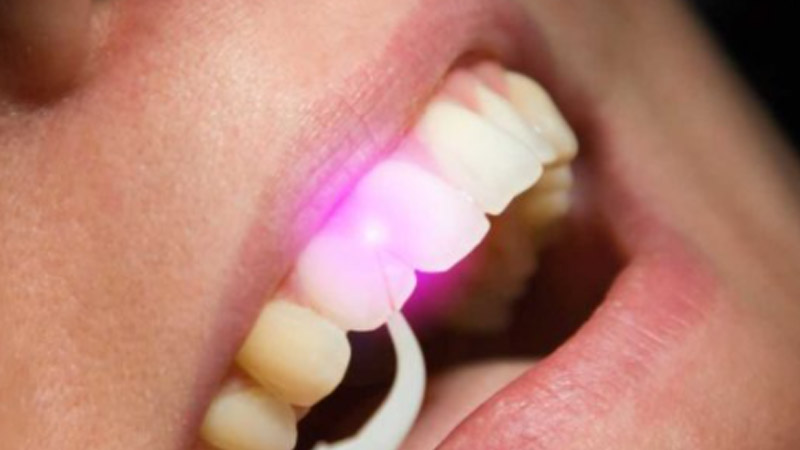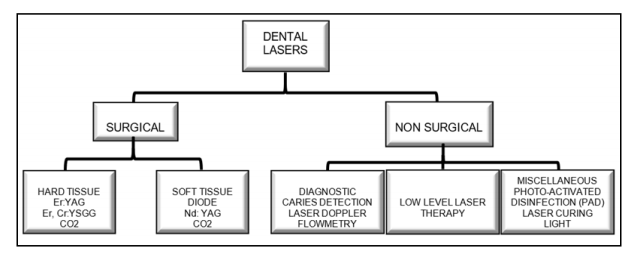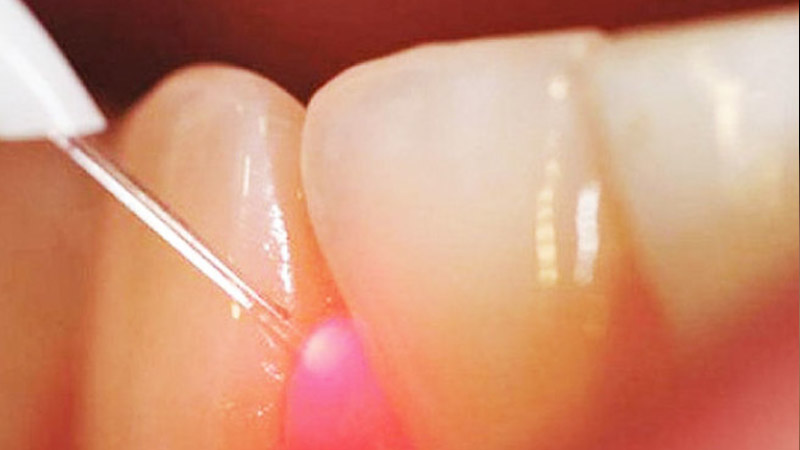
Classification of Dental Lasers Based on Wavelength and Frequency
As mentioned earlier, the wavelength and frequency of the laser light are ways of classifying dental lasers. However, these parameters of the light are dependent on the active element within the laser. They can also be classified based on the type of tissues they are used on, such as hard tissue lasers (hard lasers) and soft tissue lasers (soft lasers). Hard lasers are also termed hot lasers while soft lasers are known as cold lasers (Flowchart 1).
Visible Spectrum Lasers in DentistryLasers that are within the visible spectrum of light are the Alexandrite laser with 377nm, the blue diode laser at 445nm, Argon laser at 488nm and 514nm, KTP(Potassium Titanyl Phosphate) laser at 532nm, and He-Ne (Helium Neon) at 632nm. The rest of the laser systems used in dentistry fall under the invisible, infrared portion of the electromagnetic spectrum. Examples would include the diode laser (805, 808,810, 830, 940, 980 and 1064nm), Nd: YAG laser (1064nm), the Erbium family lasers with the Er, Cr: YSGG laser (2780nm) and Er: YAG laser (2940nm), the CO2 laser (9300, 9600 & 10600nm).
Invisible, Infrared Lasers: A Comprehensive OverviewAll dental lasers are capable of being absorbed by one or more components of the soft tissues. The lasers that are under the infrared umbrella are divided into two main categories: the short wavelength lasers in the near-infrared spectrum (800-1100nm) and the longer wavelength lasers in the mid and far infrared spectrum.

Flowchart 1
The short wavelength lasers are ideal for soft tissue procedures because of their tendency for minimal or no interaction with dental hard tissues. They are selectively absorbed by the vascular components and tissue pigments in areas of inflammation. They have a low absorption coefficient in water with scattering into healthy soft tissues to about 0.8-6.0 mm. These lasers are ideal for soft tissue procedures such as a frenectomy, operculectomy, gingivectomy, gingival troughing, periodontal pocket debridement, second-stage implant uncovering, fibroma removal, and oral biopsy etc. (all protocols have been set inside the system of Pioon dental laser devices) They are also used in direct laser irradiation in conventional laser endodontic therapy, tooth bleaching, and dentin desensitization. The longer wavelength lasers exhibit a high absorption coefficient of water. This makes them selective for soft tissue procedures due to the presence of high water content in the oral mucosal tissues. When soft tissue ablation is performed through vaporization of the interstitial tissue fluid, fragmentation of tissue structure is noted, achieving both hard and soft tissue laser applications at the same time.
 |
 |
In health sciences, the most commonly used lasers involve thermal interaction in which heat is generated following irradiation, which gets converted into controlled temperature rises in small
and specific areas of the target tissues. Microstructural and physical changes in target tissues occur depending on the rise in temperature and the laser-tissue interactions. If the lasers used are of high-power category, the effects such as vaporization, coagulation, and ablation can occur[1].
[1] P.Anitha Krishnan, Sukumaran Anil, Lasers and their Applications in the Dental Practice [J]. Dentistry Journal and Oral Sciences, November 2020.